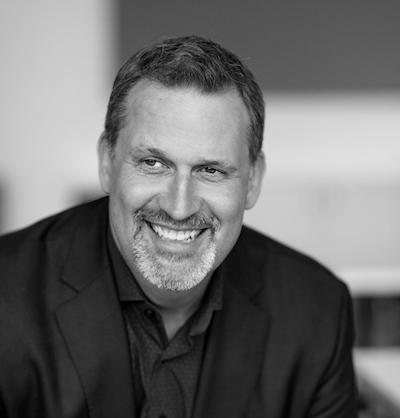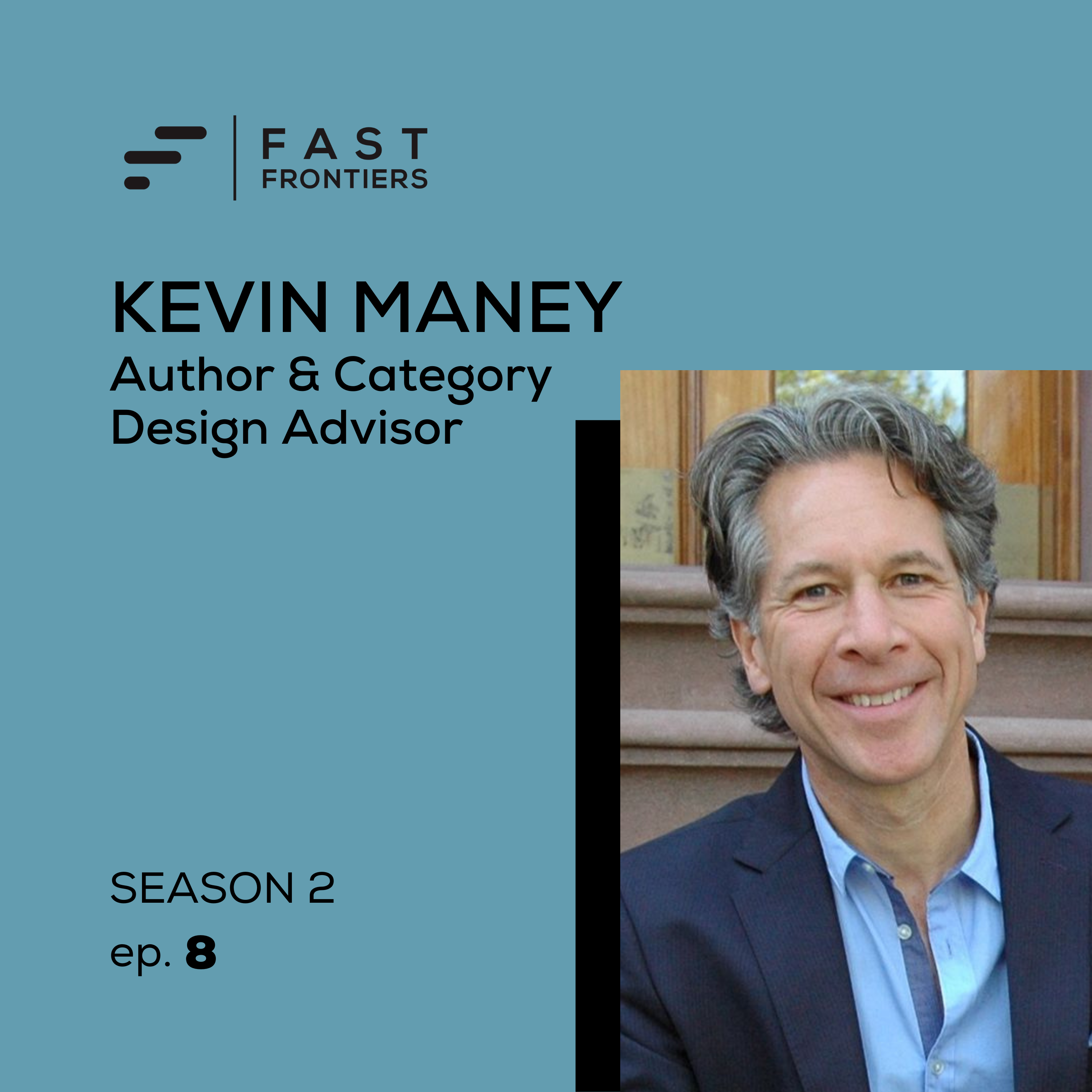S2 Ep 8. Kevin Maney: Author & Category Design Advisor
- 0.5
- 1
- 1.25
- 1.5
- 1.75
- 2
Tim Schigel : Welcome to Fast Frontiers. I am your host, Tim Schigel, managing partner of Refinery Ventures. In this episode, we're bringing you my conversation with Kevin Maney, advisor at Category Design and co-author of Play Bigger. In this episode, we're going to dive into the learnings that came out of writing Play Bigger, a book that I recommend to all of our startups. Kevin talks about how to define and own a category, as well as the timeline of successful companies that ultimately go public. So what is category design? While most companies start out with a product idea and Kevin tells us that companies, successful companies that is, start out designing the need and the category. So this involves asking a really simple question. What problems do you really want to solve? The biggest theme or so what that I hope you can take away from this conversation for entrepreneurs is that you need to spend the time defining the problem, finding that category and defining it and aligning your team to help drive the process. If you set that North Star early, you have a better chance of attracting customers and convincing others that your journey is worth it. Ultimately you can become a category king. Please enjoy my conversation with Kevin Maney. All right. So today we have with us, Kevin Maney, who's a journalist, author, and co-founder of Category Design Advisors. His most recent book, which he co-authored came out in June 2020 and is called UnHealthcare: A Manifesto for Health Assurance. Also has co-written a book called Unscaled: How AI and a New Generation of Upstarts are Creating the Economy of the Future. But the reason we're talking today is because of his book that has influenced so many people called Play Bigger: How Pirates, Dreamers and Innovators Create and Dominate Markets. Kevin's also been a contributor to Newsweek, Fortune, The Atlantic, Fast Company, Strategy and Business, Harvard Business Review, CNN, ABC News and others. And to my delight and surprise, I also found out that Kevin's side hustle is as a singer, guitar player with the New York City rock band called Total Blam Blam. Awesome. Unfortunately, we're recording this from my office and not my home studio with all the guitars in the background this time. So that was awesome to learn.
Kevin Maney: Yeah. No, actually, yes. Otherwise, we'd be able to... I'd grab mine and you grab yours and we could do to do the whole thing in song or something.
Tim Schigel : Yeah. We could have treated our board people with our guitar playing.
Kevin Maney: Yeah.
Tim Schigel : So you and I met a couple years ago, at Esther Dyson's PC Forum reunion.
Kevin Maney: That's right.
Tim Schigel : In Scottsdale, which you and I probably both attended several times back in the'90s, I guess.
Kevin Maney: Yeah.
Tim Schigel : Great group of people. That was really fun to see everybody there. That's when I learned about your background and Play Bigger. I read Play Bigger. It's actually, looking across my room, it's at the top of my book stack where I meet entrepreneurs. I recommend it to every single entrepreneur and I can't tell you how many times-
Kevin Maney: Thank you.
Tim Schigel : ...they come back to me later and say," That book changed my life. Oh my gosh!" And I'm a big customer-driven design kind of guy. That's the work I used to do in Asia and other places, so it aligned very well with what I had learned in my experiences. So welcome. Why don't you tell us a little bit about Play Bigger and the original inspiration for it?
Kevin Maney: Sure. Well, yeah. Actually, I'll tell a little bit of a background story. And thanks Tim for all of that. I mean, for the introduction and for having me on. I wrote it with three other guys who are Silicon Valley veterans. They've been around the block and they had already started an advisory firm called Play Bigger. And they invited me to dinner one night in San Francisco. And in their advisory firm they just had some theories, things that they worked on, worked out throughout their careers but it was all sort of centered around this idea that basic truism, in digital markets, there quickly becomes a winner take all scenario, in most categories. And, I mean, if you've got a digital market where everybody, and there's abundance, not scarcity, that means that everybody in the world could choose whatever is the best or the category winner, so they do. And you end up with markets dominated 80% by one company. And so kind of working backwards, if that's true, then that means then, if you're starting a company, or if you have an older company, if you're in somebody else's category, you're scraping around for some of that other 20%, and that's the best you're going to do. Why would you do that? Instead, go through a thought process and kind of methodology to think about, how can you find and define and then ultimately own a category of your own, where you're the guy who has 80%. And 80% of a smaller category is probably better than 5% of the bigger category. It depends on the size, but generally speaking, right? You're at a better position. So if you kind of do that reverse engineering and then say," Well, okay, well, what kind of thought process do you have to go through to really get to... Like where's the new category that we could go after and how do we own it for ourselves?" So we were kind of talking about all this at the dinner and they said," Maybe there's a book here." I thought, from all I knew from journalism, from covering technology for 20 some years that they were on the right track and said," Let's explore it," and it turned out to be a really interesting topic to explore. And there was really something there. And then at the same time, the four of us just jelled and it was actually one of the most fun times I've ever had in my career, actually, working on this book with those guys. But ultimately what the book ends up being is a methodology that we call Category Design, for doing exactly what I said. Thinking through this idea of how do you define and ultimately own a category of your own. Turns out that it's just a really great way for a company to think about it's strategy. There's probably 100 or 1000 other ways for companies to think about their strategy, but for some reason, this one seems to resonate and really seems to work. So, I mean, like you said, in your opening, I mean, I've written a whole lot of books. I've never had the satisfaction of having a book where people are evangelical about it. I mean, it's just crazy and it's so, so nice and so satisfying to know that.
Tim Schigel : That's awesome. Yeah. It seems like there's some similarities between like this podcast, Fast Frontiers is about how innovation cycles are accelerating. They get faster and faster.
Kevin Maney: Yeah.
Tim Schigel : And it seems like in a similar way with categories, categories are defined potentially faster now because distribution is essentially free, with digital distribution. But also this phenomenon that there tends to be one category king versus the top three.
Kevin Maney: Right.
Tim Schigel : And that's also changed. Is that a fair comparison?
Kevin Maney: Yeah, it is. As part of this exercise, we tried to use data to try to understand some things and prove some points. And there was one surprising thing that popped out. So we pulled data from 1000s of venture-backed companies over the last 30 years and just looked for patterns, if we could think of it. And this one kind of interesting thing popped out, which was that since 2000, companies that went public, when they were between six and 10 years old, they created enormous value for their shareholders. Companies that went public before they were six years old, tended to either kind of flat- line or tank. And we looked at that over time and saw that that six to 10 year slot, over time, was moving shorter and shorter, but wasn't collapsing completely, like you think. So basically what this ends up showing, or what we interpreted as, and we took it to venture capitalists, to investment bankers. They said the pattern fits like what they intuitively knew. And we kind of teased it out to the idea that this was kind of a pattern of category creation. That somewhere around six years old, five or six years old, once a category is at that stage, is when the public finally catches on and the category goes on a rocket ride. If a company goes public in that span of time, where the category is just taking off, and the obvious category king has started to be come known, then an investment of that company is likely to pay off big time. You're catching the category king on the wave up in a category. What happens a lot of times prior to that six-year mark or five-year mark, companies go public at three years or something like that. Well, a lot of them may not turn out to be the king of that category. Somebody else is and that company collapses or goes away or the category doesn't seem to turn out to be as much of a big deal as people thought at first. A good example of that was all these sort of couponing companies that went public at three years old and the Groupon went public at three years old. It just tanked because the category didn't turn out to be what everybody thought it was going to be.
Tim Schigel : As a VC, if your business plan doesn't show you able to go public within six to 10 years or seven years, then you're missing something?
Kevin Maney: Mm-hmm.
Tim Schigel : The point you're bringing up is also interesting, which I used to call a bake time for software. Like, if you don't have a certain number of customers all using the same thing, then you don't have a product yet?
Kevin Maney: Yeah. Right.
Tim Schigel : There's a certain bake time that you need in the market, it sounds like, before it really is defined.
Kevin Maney: Exactly. And by the way, we split it out and ran for B2B companies versus B2C. An obvious thing is BtoC companies had a shorter bake time because it's a low cost thing. Consumers can choose to adopt something much more quickly than a company buying a big thing that's going to run the enterprise.
Tim Schigel : Yep. Makes sense.
Kevin Maney: But ultimately... So there's another great book called The Evolution of New Markets, by Paul Gerosci, this economist who lived in the U.K. and U.S. And he studied the evolution of categories and mapped them and how it turns out to be this pattern that seems to happen every time a new category appears. But one of the things that he was emphatic about is that there's a public psychology factor involved. People have to get comfortable with something before they choose what he calls a dominant design. So, usually if there's a bunch of different versions of something that's popping up, the public has to get comfortable enough to glom onto a dominant design. And once that dominant design gets chosen, everybody feels even more comfortable because now you know that thing is not going to get replaced by something different in a year. So if I buy this, I don't have to throw it away in a year and get the different version or whatever. And that's when these things take off. While distribution bottles and everything else can get shorter and shorter, you can develop products faster and faster and all those things, there's an element of you can't change human psychology as much as you can change the how fast you can build and distribute products.
Tim Schigel : Psychology and it sounds like network effects, right? So when Uber first came out, maybe you had been apprehensive, maybe you didn't trust it. But after three friends tell me they just got out of an Uber-
Kevin Maney: Exactly. Right.
Tim Schigel : Well, maybe I should try Uber, right?
Kevin Maney: Right. Yeah. That's true. Right.
Tim Schigel : So there's like a density issue. But one of the things I loved, being a customer-driven design kind of person, I believe your starting point is, it's not about being first to markets, to first to define the problem.
Kevin Maney: Yeah. It is.
Tim Schigel : Can you talk a little bit more about that?
Kevin Maney: Sure. So the core thing that we do with a company at the beginning is work and work and work at this very simple question of what problem do you really solve? And it's amazing how hard that question is and how much thinking it produces when you actually like... And especially when you're really disciplined about saying, "No, no. You're describing what you do, you're not describing what the core problem... What's that problem that somebody wakes up with a knot in their stomach and has to solve and you're the one who's going to solve it? It's a really hard question-
Tim Schigel : It's such a large percentage of, especially tech companies, because people say, "Wow, look what I can do."
Kevin Maney: Right.
Tim Schigel : And all of a sudden they think they have a company and it must be 70 or 80% of the time, these companies are focused on the solution, "Wow, look what I made."
Kevin Maney: Right. Exactly.
Tim Schigel : And hadn't really thought about it. Maybe they thought about it intuitively what the problem was, but they didn't really get into analyzing it qualitatively and quantitatively to understand what's the real problem.
Kevin Maney: Yep. That's true. No, that's really true. And so that's a core question that we start with is like, "What problem do you really solve?" I mean, we've had to get a leadership team in a conference room and spend four or five hours just on that quick question alone. But when you get the answer, it's incredibly enlightening and you can build from there.
Tim Schigel : So what would you say to somebody who said, "Well, wait a minute. How about Steve Jobs and the iPhone?" What happens if people don't recognize the problem?
Kevin Maney: Okay. I got a story. So let's actually use the iPad because I know this story quite well from retelling. One of the things we talk about with the problem statement is that to find a new category, there are two good ways to do it. One is to solve an old problem in a way people didn't think it could be solved. So people know the problem. They just didn't think there was anything they could do about it. And so you're coming along and saying, "Well, we can." There's a different version that is to tell people that they have a problem they didn't even know they had.
Tim Schigel : I love that one.
Kevin Maney: And I think Steve Jobs was actually wonderful at that. And so when he comes out, he's going to introduce the iPad and this was actually the unveiling. And he goes out and he puts up on the screen on one side, an image of an iPhone. On the other side, an image of a MacBook. And he says, "Well, we're in a new media universe now. And it's this new world of digital media or consuming TV shows and movies, books, music. Everything is coming to us digitally. You've got this phone, which is cool but it's too small to really watch this digital content on. And you've got this laptop and it's too big because you can't really lounge on the couch in front of the fireplace or whatever, and use your laptop to watch something. And so we're introducing this..." And he literally uses the word... "We're introducing this new category that sits in between, call it a tablet. Our version is an iPad." So what he was doing was he was telling us, reminding us of all these things we probably already knew the pieces of, that there's all these digital content things are happening, but telling us that, "You know what? You're starting to consume all this digital content. You don't really have a good way to do it." And then you go, "Hell, actually he's right. I mean, this phone sucks, looking at a movie on that and the laptop's full, whatever. And so I guess I want an iPad. I never knew I did before, but Steve Jobs just told me why I needed one." So that's a version of being able to describe to people a problem they didn't even know they had.
Tim Schigel : That's funny because funny you mentioned that example because of what you mentioned earlier with the network effects and psychology. When it came out, I was skeptical. And I'm a gadget guy, but I'm like, "Oh, another gadget, tablets." But it wasn't until sitting on an airplane, which you and I do a lot and again, probably about the third time the person next to me had an iPad and I saw them working and how nice it was. I was like, "Okay, I got to get one."
Kevin Maney: Right.
Tim Schigel : And now I wouldn't go without one. Right?
Kevin Maney: Right. Exactly. Yeah.
Tim Schigel : So what kind of tips could you give entrepreneurs in trying to figure that out?
Kevin Maney: So another thing we talked about when we work with companies and actually this is not in the book. There's another great book called Where Good Ideas Come From, by Steven Johnson. One of the concepts he uses in the book is something called the adjacent possible. So he said there's the realm of what exists. The possible, right? And those are things that technology is already good at and that society, or we, as people already accept and have adopted into our lives. So today, like TV set or a laptop is well in that possible range. And then there's this other universe outside of that, which is the not yet possible. And that's, technology is still a little iffy and it doesn't quite work right. We're still skeptical of it. Maybe it's still some early, early adopters. Something like a Oculus virtual reality headset. But then there's this band between them that he calls the adjacent possible, which is just beyond what we, as people understand or can accept. Just a little beyond what technology has always been able to do, but it's there. It's possible. It's tangible. It takes somebody to show it to you. But when we talk to companies, we say, "Okay, well, if you're talking about creating a product or a service, that's well within that possible, in that existing bubble, it's not very interesting. You're probably bettering somebody else's market. You're going to scrape for some market share. But if you can look out and see how the world should be, but can't be yet because people don't quite understand it, technology doesn't quite do it, but you're convinced that the world has to be that way and then look backwards and find where the adjacent possible is, that that can lead you in a straight line to that vision. And let's let's define that adjacent possible category." But that turns out to be a really effective way to help them think because now you're forcing somebody to think beyond what exists. You're forcing them to think about how the world should be, if it only could. And then work backwards to how can we make that happen, starting very soon and then push it out to there.
Tim Schigel : Do you remember, what would be a good example of that?
Kevin Maney: Well, let's see. I mean, when Bezos, Amazon, dreamed up AWS. I was working for USA Today at the time. I was just a technology columnist. I had interviewed Bezos, over the years anyway and I was at a technology conference in 2006. I got a call on my cell phone from this PR person saying, "Can you come up to the suite..." Whatever it was. "Jeff's up there. He wants to tell you about something that they're introducing." And so he sat me down and he talked me through this thing that he was calling the elastic compute cloud about computing by the SIP. And these were all phrases that he was using. Now the idea of cloud computing, that you could buy with your credit card, was not in any realm of the possible. And in fact, I ended up looking across the table at him. He took like 20 minutes trying to explain this thing to me and I said, "Well, how in the world are you going to tell the public about this?" And then he said, "Well, that's why you're here." But he clearly understood that the world should be able to do this. Startups should be able to pull out a credit card with a couple of guys in a garage, buy all those capabilities and just go and just start doing it. But the ability to do that didn't yet exist. And he had to start with something that people could understand a little bit more, so that's why all this language about computing by the SIP and all this kind of stuff. But clearly, I mean, this was something that the way the world eventually was supposed to be. That's an example of getting on that boat early, right?
Tim Schigel : That's a great example. One of the examples from your book that I use a lot with entrepreneurs on defining the problem, maybe you can share this example was... And not just defining it, but the marketing that they're doing in the early days was Salesforce. Can you tell that story?
Kevin Maney: The idea that a corporation would put its data on somebody else's computer through the cloud, that was what was really sort of out there as an idea, when Benioff got going. And yeah, we celebrate Salesforce in the book, as one of the great category creation stories because Benioff went out there and he started telling companies that these giant CRM systems that they installed were a problem. Companies up to that were thinking that CRM thing was a solution but the fact that they had to install this complicated software, that cost a whole lot of money and often broke down and was difficult to train people to use and all this stuff. And so he defined that as a problem that companies didn't really know they had. But of course, once he would say that, if they said, "Well, yes, I guess that is a problem, but what's the solution?" Well, if somebody says, "I have this solution. It's actually, you let us run all of that. Just connect to our computers and through the cloud and all the software updates and when all that stuff happens if we do it, blah, blah, blah." And so he consolidated all of that into that very simple, no software slogan and that symbol-
Tim Schigel : And that was like the no-smoking sign.
Kevin Maney: The little no smoking sign with software in the middle.
Tim Schigel : It wasn't a Salesforce logo.
Kevin Maney: Right.
Tim Schigel : The problem was the image and the message.
Kevin Maney: Right. That's exactly right. Right. And we tell companies today that in a lot of cases, it's more powerful to market the problem, to essentially market the category, than it is your product. You convince people they have this problem that nobody can solve but you. And then you say, "Hey, there's a solution. I've got this. Aren't we great? We're going to help you out."
Tim Schigel : And it implies you understand it?
Kevin Maney: It implies you understand it.
Tim Schigel : Which builds up trust and all of these things.
Kevin Maney: That's right.
Tim Schigel : Right.
Kevin Maney: We tell companies all the time, be a category, not a product. And know that creating a category is different from creating a product. Creating a category is about opening a space that you know others are going to come into. And that's fine. I mean, you just want to make sure that you're always the one who stays on top and is that dominant design and becomes the king of this category. But a category prospers when there's others in it.
Tim Schigel : Well, and when you frame your business that way, you're likely to be in business for a longer period of time, because you're not focused on your product. It gives you the freedom and flexibility to adapt by constantly being in touch with and aware of the problems because the problems change. And Jeff Bezos has also done a great job of that and has talked about that. He said, "As long as people are dissatisfied with things, we're going to be in business."
Kevin Maney: Right. Right.
Tim Schigel : So we invest for example, companies, when they have early signs of decent product-market fit, they have maybe about a million in revenue, what are the best ways for companies at that stage or coming up to that stage to go about understanding their category? What sort of the process or the protocol that you would suggest they go through in those early days?
Kevin Maney: I would say that most every company does not start out thinking along the lines of a category. Most start out with a product. Somebody says, "I have an idea for something I can build." There actually seems to be two ways companies get started. And so some, a lot of companies start out with some engineers saying, like, "I have an idea for this thing I can build. It's going to be really cool," whatever. There are another set of people who see the problem first and say, "I'm going to try to solve this thing," and then they hire engineers to build that thing. I think that's a minority, from what my experience has been. But those seem to be the two ways that startups really happen. Either way, what we've discovered... So we've done a lot of work with companies that were somewhere between two and three years old, maybe just between somewhere between series A and C, which means that they got started and they already got some traction and they did kind of what they started out to do. And then they get to this point where they're a little bit unsure of what's next. And that seems to be a really good moment in time to have this category conversation. To really dive into it because you have enough... And those are also the moments when we go in and you get 10 people in the leadership team around the table and you ask all 10 of them what the company does and where it's going next and they're all 10 different answers. What the company needs at that point in time, it's to decide on what is the category, what is our North Star and have every one of those 10 people agree on it. And this category conversation is a good forcing function for that. Because if you all have it together, you drive it and drive it until you all agree that you've got it, now you've got a flag on the hill to go towards.
Tim Schigel : So important. I was just actually, just before we got together today, talking about that exact thing with another one of our CEOs.
Kevin Maney: Yeah.
Tim Schigel : Because obviously if you're not aligned, you're just flapping around in the wind, right? It's just so hard to make progress. Any final thoughts for entrepreneurs out there who are working through this category design issue?
Tim Schigel : No. I thought I'd tell one story about agility with this category process. Something that has become front and center because of the times we're going through. This whole COVID craziness. There's a company we worked with that I'm going to give a lot of credit to in that realm. So it's a company called SnackNation out of L.A. And some of your listeners who are in tech companies may actually know of them because they had a business of basically putting the snacks in break rooms and mostly at these sort of 200 person millennial tech companies. So the snacks that they sourced were all like micro brand, funky, cool snacks. And then they had this technology back-end, where people could, with surveys and answer questions, so they could start to personalize to that company what kinds of snacks and things like that, that that company wanted. And they were doing really well with us. Business was taking off and we did some category work with them. COVID hits. Offices go away and suddenly they're faced with this crisis of like, well, this category now looks a lot different than it did before. And so we did some rethinking with them and realizing that in this universe where companies are virtual or some sort of blending of virtual in office, or whatever, the idea of the company culture starts to become fragmented or difficult to hold together. And there's lots of things that hold the culture together. Some of its philosophy and ideals and all those kinds of things. But some of it is the physical spaces and the physical aspects of a culture of what the office is like. And yes, the snacks everybody has in the snack room or the little gifts that get handed out when somebody does a good job. So we came up with this phrase. I think it was a really cool phrase. That companies now need a cloud culture. And that cloud culture is, like I say, part ideals and philosophy, part tying people together with technology or whatever, but you still need that physical aspect that helps tie that cloud culture together. Now people are all at home, so how do you do that? Well, let's change this so that we're sending the same kinds of snacks that people had in the office and back at that company, to their homes and add other things. Like if there's little rewards for hitting a sales quote, blah, blah, blah, stuff like that, they used to package those up. So now everybody has the same thing coming to their house and sitting next to them at their laptop, whatever. So I give them credit for seeing how things are changing, having this category conversation around the change, and seeing a new opportunity, and that last I heard, that has been going great for them. So it's just a point of sometimes things change in a really big way and this method of thinking it through can really be helpful at those times.
Tim Schigel : That's a great example. I love that term, cloud culture. Matter of fact, Brad Stulberg, author, wrote Peak Performance: Elevate Your Game and he talks about eight things for peak performance you need. And one of those is, he talks about strength without flexibility is rigidity, and flexibility without strengths is instability.
Kevin Maney: That's a good phrase. I like that.
Tim Schigel : So you need both. You need to strength and that flexibility.
Kevin Maney: Right.
Tim Schigel : And recognize, "Hey, things are different, right? Our back's up against the wall. We've got to think differently."
Kevin Maney: Yeah, exactly. Yeah.
Tim Schigel : Well, that is a great example. And I appreciate so much, Kevin, you sharing your thoughts on category design and wish you all the best with all your future endeavors and books.
Kevin Maney: Thanks.
Tim Schigel : Thanks for contributing to Fast Frontiers.
Kevin Maney: And one of these days, when we're actually allowed to see each other, we got to get the guitars out and play some stuff.
Tim Schigel : Absolutely. We'd love it. Bye Kevin. Thanks.
Kevin Maney: All right, Tim.
Tim Schigel : Thanks for listening to Fast Frontiers. If you like our show and want to know more, check out our website, fastfrontiers.com. If you enjoyed this episode, please share it with others and give us a rating and review on your favorite podcast platform. Join us next week when we bring you my conversation with Bruce Vojak, managing director at Breakthrough Innovation Advisors.
DESCRIPTION
Today we're bringing you my conversation with Kevin Maney, advisor of Category Design and co-author of Play Bigger. In this episode, we're going to dive into the learnings that came out of writing Play Bigger, a book that I recommend to all of our startups. Kevin talks about how to define and own a category, as well as the timeline of successful companies that ultimately go public. So what is category design? While most companies start out with a product idea, Kevin tells us successful companies start out by designing the need and the category. So this involves asking a really simple question. What problems do you really want to solve? Spend the time defining the problem, finding that category and defining it, and aligning your team to help drive the process. If you set that North Star early, you have a better chance of attracting customers and convincing others that your journey is worth it. Ultimately you can become a category king.
Please click on any related resources below for more information about what we discuss in this episode.
Today's Host

Tim Schigel
Today's Guests








